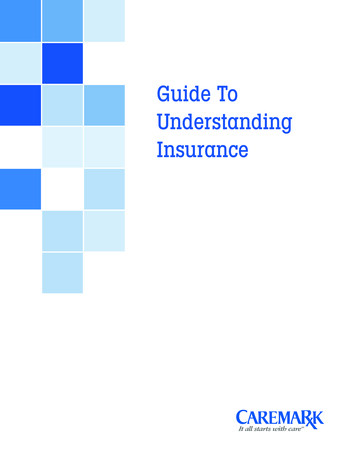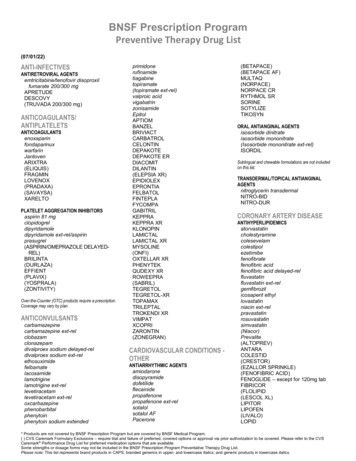
Transcription
Guide ToUnderstandingInsurance
Table of ContentsIntroduction .1Health Insurance ProgramsOverview .Health Insurance .Traditional Indemnity Plans .Self-Funded Insurance .Taft-Hartley Plans .Managed Care Plans .Health Maintenance Organizations .Preferred Provider Organizations .22234455Public (Government) Health PlansSupplemental Security Income .Social Security Disability Income .Medicare .TRICARE .Civilian Health and Medical Program of the Veterans Administration .Medicaid .State Children’s Health Insurance Program .Children with Special Healthcare Needs .AIDS Drug Assistance Program .Comprehensive Health Insurance Programs .67710111213131414Laws That Affect Healthcare BenefitsEmployment Retirement Income Security Act .Consolidated Omnibus Budget Reconciliation Act .Employee, Spouse, Dependent Child .Health Insurance Portability and Accountability Act .Americans with Disabilities Act .1515161820Note: In this book we talk about co-payment. Co-payment or co-pay means the amount a participant isrequired to pay for a prescription in accordance with a Plan, which may be a deductible, a percentage ofthe prescription price, a fixed amount or other charge, with the balance, if any, paid by a Plan.
IntroductionHow well do you know your healthinsurance plan? Do you know whether youhave private insurance or public insurance?Whether you have a group plan or anindividual plan? Can you see any doctoryou want, or must you see an approveddoctor? What expenses are you personallyresponsible for and what expenses will bepaid by your insurance? Will your benefitscontinue if your medical bills exceed 100,000? 500,000? And mostimportantly, what are your options forhealth plan coverage if you want tochange jobs? Will you be coveredimmediately under your new employer'shealth plan, or will you have to wait someperiod of time because of a preexistingcondition? Making sense of your healthplan is no easy matter; however, you oweit to yourself and your family to understandyour health plan as if your life dependedon it – because it could.1This booklet was developed tohelp you:n Understand the numerous types ofhealth insurance coveragen Understand current laws that may affectyour access to a health plan andhealthcaren Evaluate your existing health plan toensure your immediate and futuremedical needs will be metn Identify other health plans and programsthat may offer you more benefits orprovide you with health plan coverage ifyour current plan should terminateThis booklet is not intended to provide youlegal advice. You may wish to contact yourown legal advisor with regard to lawsaffecting healthcare and healthcareinsurance. If you would like additionalinformation about this booklet or itscontents, please contact the CaremarkCustomer Assistance Hotline at1-800-331-7171. We hope you find thisbooklet helpful!
Health Insurance ProgramsOverviewHealthcare delivery and financing havechanged considerably over the past 20 years.Technological advancements, including newequipment, supplies, and drugs, havesignificantly improved patients' quality of life.In the past, individuals were restricted toreceiving care in their doctor's office, or forserious illnesses, in the hospital. Today they areable to have their medical needs met in avariety of settings including outpatient clinics,ambulatory surgery centers or even in theirown home. Unfortunately, these new medicaladvances have also brought about asubstantial increase in healthcare expenses,causing a reevaluation of the manner in whichhealthcare is currently financed.Health InsuranceMany health insurance organizations exist inthe United States. Blue Cross/Blue Shield plansare probably familiar to most individualsalthough there are many other privatecompanies through which private insuranceplans are available. The majority of individualshave private health coverage through anemployer. These group insurance policiesusually offer greater benefits at lower coststhan individual policies, because the risk isshared across the entire group. With this typeof insurance, the employer may pay all or partof the premiums. Individual insurance policiesare purchased from an insurance company bya person who pays the premium directly to theinsurance company. Several types of employergroup health coverage are available:traditional indemnity plans, self-funded plansor Taft-Hartley plans. When purchasing privateinsurance, two plans are available: a traditionalindemnity plan or a managed care plan.Traditional Indemnity PlansQ1.A1.Q2.A2.Q3.A3.Caremark Customer Assistance Hotline 1-800-331-7171What are the types of coverageoffered?Typically, indemnity plans offer basichospitalization and major medicalcoverage. Basic hospitalization is usuallylimited to in-patient services, whilemajor medical can include doctor andnursing services, x-rays and diagnosticservices, durable medical equipment,chiropractor services, and prescriptiondrugs. Some policies may stipulate thatsome drugs (usually non-injectables) arecovered under the prescription drugbenefit. Some policies also offerhomecare and hospice coverage.What limitations do I haveregarding a choice of provider?This plan generally has no restriction onyour selection of doctor, hospital andother healthcare providers. However,these plans may pay a predeterminedamount for services based upon theplan's rule of usual and customary ratesfor the provider's geographical location.You may be financially responsible forthe difference between the amountbilled by the provider and the amountpaid for the service by your plan.What costs will I beresponsible for?Typically, you will be responsible for allor part of a premium (depending uponwhether this is an individual or groupplan), a deductible co-payment (ifapplicable), and coinsurance. As ageneral rule, the lower the deductibleand coinsurance, the higher thepremium. Most plans limit yourcoinsurance after you have paid thedeductible and a certain amount2
"out-of-pocket." For example, yourplan may stipulate an annualdeductible, a coinsurance amount anda maximum out-of-pocket (includingthe deductible). Before any services canbe paid by the insurance plan, youmust pay the deductible. After thatobligation has been fulfilled, the policywill reimburse the provider a certainpercentage based upon your policy.After meeting your out-of-pocketexpenses, you are no longer responsiblefor your coinsurance, and the plan willreimburse 100% of covered servicesuntil this policy period ends. Forexample:Monthly premiumAnnual deductibleCoinsuranceMaximum out-of-pocketQ4.A4.Q5.A5.3Plan A 300 1,00020% 3,000health plan description carefully todetermine if you have any benefitlimitations.Q6A6.Plan B 600 50010% 1,000Are there any other costs I mightbe responsible for?You may be responsible for the cost ofany non-covered services, as well as anyamounts the provider bills in excess ofthe plan's usual and customary charge.What about annual or lifetimemaximum benefits?While basic hospitalization plans don'tgenerally have annual or lifetimemaximum benefits, the majority ofmajor medical and prescription drugplans do. Benefit levels for prescriptiondrug plans are usually based on amonthly or annual benefit, if there is abenefit limit. Major medical planstypically have a lifetime maximum. Thedifference between a 50,000 and a 500,000 lifetime maximum issignificant, especially if you have achronic medical condition. Check yourCan I be excluded from coveragedue to a preexisting condition?It depends. Under the Health InsurancePortability and Accountability Act(HIPAA), a preexisting condition clausemay not last for more than 12 months(18 months for late enrollees). If youhave had continuous coverage withouta break of 63 days or more, you maybe able to "credit" your previous healthcoverage against the waiting period ofyour new insurance plan. Twelvemonths of continuous coverage beforeyour new plan began would allow youto begin receiving benefits immediately;a lesser amount (for example, 6months) is still significant, as it wouldallow the waiting period to be reducedby that time period. If HIPAA rules donot apply, preexisting conditionexclusions typically range from 3 to 18months, during which time you wouldbe completely responsible for paymentfor services associated with yourpreexisting condition.Q7. Who handles complaints about myindemnity insurance carrier?A7. The state Department of Insurancehandles complaints regarding indemnityinsurance carriers.Self-Funded InsuranceQ8.A8.What is self-funded insurance froman employer?Self-funded insurance is a way by whichemployers put money aside forpayment of the healthcare (self-fund)rather than buy a traditional indemnityinsurance policy for the group.
Q9.A9.Who offers self-funded plans?Many large employers offer self-fundedplans.Q10. Are self-funded plans covered bythe same laws that governindemnity plans?A10.No. Self-funded plans are governed bythe Employee Retirement IncomeSecurity Act (ERISA). This is a federallaw, not a state law.Q11. Do self-funded plans offer the samebenefits as indemnity plans?A11. Typically, the benefits of a self-fundedplan are very similar to those offered byan indemnity plan.Q12. How will I know what benefits myself-funded plan offers?A12. All self-funded plans are required togive the employee a Summary PlanDescription with detailed informationon what services are covered,deductibles, co-payments, maximumout-of-pocket, lifetime maximums.Q13. Does HIPAA cover self-fundedplans?A13. Yes, HIPAA does cover self-fundedhealth plans in the same way it coversindemnity plans.Q14. Who handles complaints about aself-funded plan?A14. The United States Department of Laborhandles complaints regarding selffunded plans.Taft-Hartley PlansQ15. What is a Taft-Hartley plan?A15.A Taft-Hartley plan is another name fora union health plan.Q16. What law covers a Taft-Hartleyplan?A16. A Taft-Hartley plan is also covered byERISA and is required to do most of thesame the things that a self-funded planis required to do.Q17. Does HIPAA cover a Taft-Hartleyplan?A17. Yes, HIPAA does cover a Taft-Hartleyplan in the same way that it coversindemnity and self-funded plans.Q18. Who handles complaints regardingTaft-Hartley plans?A18. The United States Department of Laborhandles complaints regarding TaftHartley plans.Managed Care PlansAs stated earlier, although advances in themedical field have greatly benefited patients,improvements in the quality of medical carehave come at a high cost. The primary goal ofmanaged care is to provide medicallyappropriate care in a cost-effective manner. Toachieve this goal, health plans manage youraccess to providers, treatment settings, andthe number and types of services you mayreceive as a covered benefit. For example, youmay have to choose from a limited list ofdoctors and hospitals; you may have to receivea referral from your primary care doctor beforeyou can see a specialist; or you may have toreceive prior authorization or a second opinionbefore you can receive a prescribed treatmentor products. Once only available from privateinsurance, managed care plans are now alsobeing offered by public health programs.Caremark Customer Assistance Hotline 1-800-331-71714
Health Maintenance OrganizationsHealth Maintenance Organizations (HMOs) aremanaged care plans in which the healthcareprovider is also the insurer: Kaiser and Cignaare two examples. This is typically the mostlimited type of managed care plan, regardingyour choice of provider. Care is monitored by aprimary care doctor, commonly known as agatekeeper. This individual is responsible for allreferrals, treatment plans, sites of service,treatment and review standards, and has afinancial incentive to provide medicallyappropriate care in a most cost-effectivemanner.There are different operating plans of HMOs.The most common are: staff-model, groupmodel and network-model. A staff-modelHMO consists of a group of doctors who areeither salaried employees of a group practicethat is an important part of the HMO plan, orsalaried employees of the HMO. Healthcareservices in staff plans are delivered at HMOowned health centers. There are two kinds ofgroup-model HMOs: a) the closed-panel plan,in which medical services are delivered in theHMO-owned health center or satellite clinic bydoctors who belong to a legally separatemedical group that only serves the HMO, andb) the plan in which the group of doctorsdelivers medical care. A network-model HMOis an organizational form in which the HMOcontracts with a network of medical groups toprovide healthcare services.Q19. What are the advantages of thistype of plan?A19. Typically these plans are comprehensive,providing all of the services (andpotentially more) that are offered underindemnity plans, or self-funded plans,while being less costly. You areresponsible for a premium (there is5usually no deductible), and a minimalco-payment per office visit. (The copayment structure typically changes forhospital, ancillary and other services.)These plans usually don't havepreexisting condition waiting periods.Q20. What if I choose to receive careoutside of the plan?A20. Usually, care you receive outside of theplan is at your own expense. However,there are situations in which careoutside of the plan may be coveredwith a referral from your primary caredoctor. For example, care required froma specialist that is not available withinthe plan, is generally covered with areferral from your primary care doctor.Also, some HMOs now offer a Point ofService (POS) component. Using thePOS option, you may select doctors andother healthcare providers who areoutside of the plan. However, using thePOS option may change yourdeductible and co-payment obligation.Preferred Provider OrganizationsAs compared to an HMO, a Preferred ProviderOrganization (PPO) is a group of doctors,hospitals, and other practitioners thatcontracts with a payor to provide services at adiscounted rate to preferred providers. Benefitshave already been agreed upon with thehealth plan; therefore, the patient is usuallynot responsible for the amount the providermay bill in excess of the health plan's usualand customary charge.Q21. How does a PPO compare with atraditional indemnity plan, selffunded plan, Taft-Hartley plan oran HMO?
A21.Similar to a traditional indemnity plan,a PPO will usually allow you to see anetwork provider without a referralfrom your primary care doctor. Also likean HMO, your out-of-pocket costs maybe lower, benefiting from thecontractual relationship between yourprovider and the plan. A PPO provides alarger selection of healthcare providers,better out-of-network benefits, and isless restrictive with accessing specialists.Self-funded plans and Taft-Hartley plansmay also be part of a PPO. TheSummary Plan Description wouldspecify the financial differencesbetween using the PPO networkproviders and the non-PPO providers.Q22. Will my costs be different if I see aprovider who is not a member ofthe PPO?A22.Yes. If your provider is a participatingprovider of the PPO, then you will beable to enjoy the special contract rates,which may result in reducedco-payments to you. If your provider isnot participating in the PPO plan, youmay still receive care, however, yourout-of-pocket costs may be higher.For example, let's say your provider'snormal charge is 100. As aparticipating provider, the contractedfee may be 60. The plan pays 80% ofthe contracted rate (which is 48 in thisexample) and you are responsible for20% (in this example, 12). If yourprovider is non-participating, the planwill still only pay 48, but you will beresponsible not only for the 20%coinsurance ( 12), but also for thedifference between your provider'scharge of 100 and the contracted rateof 60. As a result, for using a non-participating provider, your out-ofpocket expense will be 52 ratherthan 12.Participating Non-ParticipatingProviderProviderProvider'sCharge: 100 100Insurance'scontracted rate: 60 6080% paymentby insurance: 48 48Patientcoinsuranceresponsibility: 12 52( 60 - 48)( 100 - 48)Public (Government)Health PlansSupplemental Security IncomeSupplemental Security Income, (SSI), is aprogram run by the Social SecurityAdministration that provides monthlypayments to the elderly, the blind, and peoplewith disabilities who have modest income. Toreceive SSI checks, you must live in the U.S.and be a U.S. citizen or national. (Certainnoncitizens may also be eligible.) Thesemonthly payments generally represent 552for one person, and 829 for a couple,however, they can vary based upon yourincome and what state you live in. Indetermining your income, the governmentreviews your cash, bank accounts, stocks andbonds, earnings, Social Security checks,pensions, and non-cash items you receive,such as food, clothing or shelter. There areseparate rules for working and non-workingapplicants.Contact your nearest Social Security office orcall Social Security's toll-free number,1-800-772-1213, or log on to www.ssa.gov toCaremark Customer Assistance Hotline 1-800-331-71716
learn more about this program. You may alsocontact the Caremark Customer AssistanceHotline at 1-800-331-7171.Social Security Disability IncomeSocial Security Disability Income (SSDI), is aprogram run by the Social SecurityAdministration that provides monthlypayments to individuals who have a severeimpairment and are unable to perform anygainful work activity (not just the job you wereperforming at the time the disability began).Q23. When do I become eligible forbenefits?A23. If you have paid social security taxesover a sufficiently long period to be"fully insured," and contributed to theprogram recently enough to have"disability insured status," you areeligible for benefits after you have beendisabled for five months, and if thedisability is expected to last at least 12months.Q24. How are the payments calculated?A24. Your payments will be based on yoursalary and the number of years youhave been covered under SocialSecurity.Q25. How does receipt of SSDI enableme to receive Medicare benefits?A25. After 24 months of SSDI benefits, youqualify for Medicare.Q26. Is there a time limit on SSDIbenefits?A26. No. You will continue to receive adisability benefit as long as yourcondition keeps you from working.However, your case will be reviewed7from time to time to determinewhether there has been improvementin your condition, and whether you arestill eligible for benefits. If you are stilleligible when you reach 65, yourdisability benefit will automaticallyconvert to retirement benefits.Q27. How can I learn more about thisprogram?A27. Contact your nearest Social Securityoffice or call Social Security's toll-freenumber, 1-800-772-1213, or log on towww.ssa.gov to learn more about thisprogram. You may also contact theCaremark Customer Assistance Hotlineat 1-800-331-7171.MedicareMedicare is a federally sponsored health planfor people 65 years of age and older, certainyounger people with disabilities (see SSDIdiscussion), and people with end-stage renaldisease. Qualified individuals now have theirchoice of the traditional Medicare program orMedicare Choice.Q28. What is traditional Medicare?A28. The traditional Medicare plan is thetraditional pay-per-visit arrangementthat allows you to be treated by anydoctor, hospital, or other healthcareprovider that participates in theMedicare program. The traditionalMedicare Plan has Part A (HospitalServices) and Part B (Major MedicalServices).Q29. What is Part A and what are mycosts?A29. Part A helps pay for care provided inhospitals, skilled nursing facilities(SNFs), hospice, and home health. If
you are eligible, you will be premiumfree, because you or your spouse paidMedicare taxes while you wereworking. If you don't qualify forpremium-free Part A, you may be ableto buy it. After payment of adeductible, you will be responsible forthe coinsurance, which will varydepending upon the care provided. Forexample, for hospitals and skillednursing facilities the coinsurance iscalculated for each benefit period (theperiod of time from admittance to 60consecutive days past the last hospitalin-patient or SNF care day) based uponyour length of stay.supplies, your coinsurance will be 20%of Medicare's approved amountwithout any out-of-pocket limitation.Q31. What are Medicare Choice Plans?A31. Recognizing the limitations of thetraditional Medicare Plan, Medicare Choice Plans provide you with a widerarray of health plan options. If youhave Medicare Parts A and B, do nothave end-stage renal disease, and livein the service area of a health plan,your options include:n Traditional Medicare Plan with asupplemental plann Managed Caren Private Fee-for-Service Plann Medicare Medical Savings AccountQ30. What is Part B and what are mycosts?A30. Part B helps pay for doctors, out-patient hospital care, and other medicalservices, such as physical andoccupational therapists, x-rays,preventive services, and limited outpatient drugs (including blood clottingfactor) when administered inconjunction with covered Part Bservices. Effective July 18, 1994, selfadministered blood clotting factors andnecessary items furnished to hemophiliapatients competent to use such factorsto control bleeding without medical orother supervision are covered andreimbursed under Part B. You areautomatically eligible for Part B if youare eligible for premium-free Part A.You are also eligible if you are a U.S.citizen or permanent resident aged 65or older. You will be responsible for amonthly premium, an annualdeductible, and coinsurance, which willvary depending upon the serviceprovided. For example, for doctors,medical and surgical services andPlan (MSA)Q32. What is the benefit of thetraditional Medicare Plan with asupplemental plan?A32.Purchase of one of the 10 standardsupplemental insurance policies mayprovide additional benefits not coveredunder the traditional Medicare Plan(e.g., prescription drugs), and help payMedicare's coinsurance amounts anddeductibles. There are two types ofMedicare supplemental insurancepolicies: Medigap and Medicare Select.Medigap allows you to go to anydoctor or hospital that acceptsMedicare. Medicare Select requires youto use plan hospitals, and in somecases, plan doctors.Q33. What is a Managed Care Plan, andCaremark Customer Assistance Hotline 1-800-331-7171how does it compare with thetraditional Medicare Plan?8
A33. A Managed Care Plan involves a groupof doctors, hospitals, and otherhealthcare professionals who inexchange for a fixed amount of moneyor other negotiated reimbursementfrom Medicare, agree to provide care toMedicare beneficiaries. Managed CarePlans include health maintenance plans(HMOs), HMOs with a Point of Service(POS) option and Preferred ProviderOrganizations (PPOs). A Managed CarePlan, may, or may not, be right for you,depending upon how you value choiceof provider, benefits, need forspecialists and cost. In comparing theManaged Care Plan to the traditionalMedicare Plan, while your choice ofprovider may be more restricted, yourcoverage is usually better and yourcosts are usually less.For example, HMOs usually require youto use doctors and hospitals that aremembers of the plan, while PPOs andHMOs with POS options may allow youto use doctors and hospitals "outside"of the plan (although usually at greatercost). Managed Care Plans must offeryou at least the same covered servicesavailable under the traditional MedicarePlan; however, they typically offergreater benefits including coverage forout-patient drugs, vision or dental care,hearing aids, etc. While all plans(traditional and Managed Care) requireyou to pay the Part B premium,Managed Care Plans are generally lessexpensive, even when a co-paymentper visit or per service is required.Q34. How does the Private Fee-forService Plan operate?A34. Under this program you choose aprivate insurance plan that accepts9Medicare beneficiaries. You may go toany doctor or hospital you choose. Theinsurance plan, rather than theMedicare program, determines thereimbursement amount and pays theprovider. You are still responsible forthe Medicare Part B premium, as wellas any monthly premium the plancharges, and an amount per visit orservice. In addition, if the doctor billsmore than the plan pays, you areresponsible for this difference.Q35. How do I enroll/disenroll in one ofthe Medicare Plans?A35. If you are not yet 65 and alreadygetting Social Security or RailroadRetirement benefits, you are enrolledautomatically in both Parts A and B,and your Medicare card is mailed toyou about 3 months before your 65thbirthday. If you are disabled, you will beautomatically enrolled in both Parts Aand B beginning in your 25th month ofdisability, and your Medicare card willbe mailed to you about 3 monthsbefore you are entitled to Medicare.Your initial enrollment period starts 3months before you turn 65 and lastsfor 7 months. If you chose not to takePart B when you were first eligible, youcan sign up during two enrollmentperiods: general enrollment period(January 1 through March 31 of eachyear for coverage that begins on July 1of that year); special enrollment period(available to individuals who are/werepreviously covered under a grouphealth plan).You may enroll in a Medicare ManagedCare Plan or Private Fee-for-Service Planat any time, simply by contacting theplan and requesting an enrollment
form. The plan cannot refuse to enrollyou during your open enrollmentperiod (the first six months after youturn 65 and are enrolled in MedicarePart B). You may disenroll at any time,for any reason, by contacting the planor the Social Security Administration.Your disenrollment becomes effectiveas early as the first of the month afteryour request is received.You can only enroll in a MedicareMedical Savings Account (MSA) planduring the 3-month period before youare entitled to Part A and Part B, orduring November of each year. Youmust set up a Medicare MSA at a bankor savings institution. You can leave theMedicare MSA Plan by filing a requestfor disenrollment in November. Yourdisenrollment becomes effectiveDecember 31.As of January 1, 2002, disenrollmentopportunities have become limited.Q36. What if I can't afford the costsassociated with Medicare?A36. If you have Medicare Part A and yourQ37. How can I learn more aboutMedicare?A37. Contact your local Social Security officeor Medicare carrier to learn more aboutthis program. Additional information isavailable online at www.medicare.gov.You may also contact the CaremarkCustomer Assistance Hotline at1-800-331-7171.TRICARETRICARE is a regionally managed healthcareprogram for active duty and retired membersof the uniformed services, their families, andsurvivors.Q38. Are different plans available underTRICARE?A38. Yes. There is TRICARE Prime (HMO),TRICARE Extra (PPO), TRICARE Standardand TRICARE for Life.Q39. What is TRICARE Prime?A39. TRICARE Prime is the managed carebank accounts, stocks, bonds, or otherresources do not exceed 4,000 (for anindividual), or 6,000 (for a couple),you may qualify for assistance as aQualified Medicare Beneficiary (QMB),Specified Low-Income MedicareBeneficiary (SLMB) or QualifyingIndividual (QI). The QMB program paysMedicare's premiums, deductibles, andcoinsurance for entitled older anddisabled people who are qualified forMedicare Part A. If your income is toohigh to qualify for QMB, you may beable to get help under the SLMB or QIprograms. Both SLMB and QI pay yourMedicare Part B premium, but do nothelp with Part A.Caremark Customer Assistance Hotline 1-800-331-7171option. If implemented in your area,you may enroll in this plan at any time;however, there is a one-yearcommitment. If you are on active duty,you will be enrolled in this planautomatically, and assigned a PrimaryCare Manager. Your eligible familymembers may choose to also enroll inthis plan, or any of the other plansoffered, except TRICARE for LIFE. UnderTRICARE Prime, there is no annualdeductible, no enrollment fee, and noco-payments for authorized medicalvisits and prescriptions except forretirees under the age of 65. Retireesunder the age of 65 have an annualenrollment fee of 230 per individualor 460 per family. Enrollees in the10
TRICARE Prime plan have access tomedical treatment facilities andTRICARE network providers.Q40. What is TRICARE Standard?A40. TRICARE Stan
of insurance, the employer may pay all or part of the premiums. Individual insurance policies are purchased from an insurance company by a person who pays the premium directly to the insurance company. Several types of employer group health coverage are available: traditional indemnity plans, self-funded plans or Taft-Hartley plans. When .










